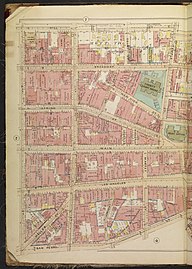
Broadway, until 1890 Fort Street, is a thoroughfare in Los Angeles County, California, United States. The portion of Broadway from 3rd to 9th streets, in the Historic Core of Downtown Los Angeles, was the city's main commercial street from the 1910s until World War II, and is the location of the Broadway Theater and Commercial District, the first and largest historic theater district listed on the National Register of Historic Places (NRHP). With twelve movie palaces located along a six-block stretch of Broadway, it is the only large concentration of movie palaces left in the United States.

The Los Angeles Chinese massacre of 1871 was a racial massacre targeting Chinese immigrants in Los Angeles, California, United States that occurred on October 24, 1871. Approximately 500 white and Hispanic Americans attacked, harassed, robbed, and murdered the ethnic Chinese residents in what is today referred to as the old Chinatown neighborhood. The massacre took place on Calle de los Negros, also referred to as "Negro Alley". The mob gathered after hearing that a policeman and a rancher had been killed as a result of a conflict between rival tongs, the Nin Yung, and Hong Chow. As news of their death spread across the city, fueling rumors that the Chinese community "were killing whites wholesale", more men gathered around the boundaries of Negro Alley. A few 21st-century sources have described this as the largest mass lynching in American history.
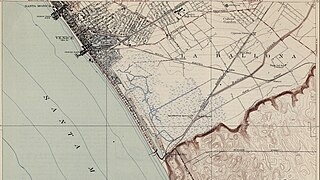
Ballona is a geographic place name in the Westside region of Los Angeles County, California.
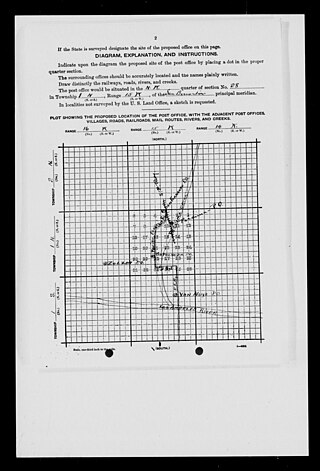
Mission Acres was a historic rural community in the northern San Fernando Valley. Its historic boundaries correspond roughly with the former community of Sepulveda and present day community of North Hills within Los Angeles, California. The community's western border was Bull Creek, which flowed south out of Box Canyon in the western San Gabriel Mountains near San Fernando Pass.
Albert Etter (1872–1950) was an American plant breeder best known for his work on strawberry and apple varieties.

Edward Kern (1860–1912) was a politician and police chief from Los Angeles, California. He also served in the war against Geronimo.

The California Nursery Company was established in Niles, California, and incorporated in 1884 by John Rock, R.D. Fox, and others. The nursery sold fruit trees, nut trees, ornamental shrubs and trees, and roses. It was responsible for introducing new hybrids created by such important West Coast breeders as Luther Burbank and Albert Etter.

The Grand Opera House was an opera house in San Francisco, which opened in 1874, and which was destroyed in the 1906 San Francisco earthquake.
The National Watercolor Society is a non-profit society which is headed by artists. Its main goal is to improve watercolor painting through trainings and exhibitions.
Selina Solomons (1862–1942) was a California suffragist active in the 1911 campaign which resulted in the passage of Proposition 4. Solomons wrote a first hand account of the movement titled, "How We Won the Vote in California".

Robert Whitaker was a Baptist minister and political activist born in 1863 in Padiham, Lancashire, England. He died in Los Gatos, CA in 1944. In 1869 he moved with his family to the United States. After attending Andover Newton Theological School he went on to hold several pastorates in the western United States including Oakland, CA, Los Gatos, CA., and Seattle, WA.

The HotelLankershim was a landmark hotel located at Seventh Street and Broadway in downtown Los Angeles, California in the United States. Construction began in 1902 and was completed in 1905. The building was largely demolished in the early 1980s following structural damage caused by the 1971 Sylmar earthquake. The "posh" hotel had nine stories, 300 rooms and two dining rooms.

The California Equal Suffrage Association was a political organization in the state of California with the intended goal of passing women's suffrage.
Lavender Lounge was a public access television show in San Francisco that aired from 1991 to 1995, one of the first of its kind in the United States. Mark Kliem was the creator and executive producer of Lavender Lounge, nicknamed "The Queer American Bandstand". In addition to dancers invited from the general public, Lavender Lounge frequently featured LGBTQ+ artists, drag queens and performers such as the queer punk band Pansy Division, Elvis Herselvis, and the Acid Housewives, the latter of whom the New York Times, reviewing Lavender Lounge, described as " three men in psychedelic-colored housedresses".

The second Los Angeles federal building in Los Angeles County, California, more formally the United States Post Office and Courthouse, was a government building in the United States was designed by James Knox Taylor ex officio and constructed between 1906 and 1910 on the block bounded by North Main, Spring, New High, and Temple Streets. The location was previously known as the Downey Block.
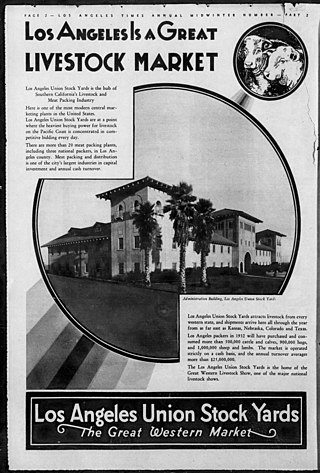
The Los Angeles Union Stock Yards were a livestock market and transfer station in the so-called Central Merchandising District south of downtown Los Angeles in Los Angeles County, California. The stock yards closed in 1960 and the facilities were demolished and replaced with other industrial warehouses.
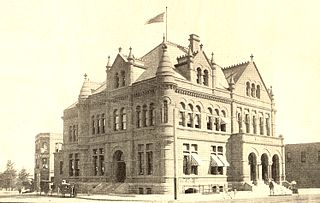
The first Los Angeles federal building, more formally the Los Angeles Federal Courthouse and Post Office or U.S. Post Office and Custom House was a Richardsonian Romanesque red brick, brownstone and terra cotta structure designed by Will A. Freret. The building, located at the corner of Main Street and Winston Street, between Fourth and Fifth Streets, was used for about nine years, from 1892 to 1901, to house the Southern District of California, a U.S. post office, and the customs office. The building was partially demolished in 1901; Court moved to the Tajo Building in the meantime. The post office was housed at a series of locations until the second Los Angeles federal building opened in 1910.

The city of Los Angeles Park Commission, originally the city of Los Angeles Playground Commission, was a supervisory committee established in 1904 that devoted to creating parks and recreational facilities for the young people of the young city of Los Angeles, California in the United States. The current City of Los Angeles Department of Recreation and Parks was chartered in 1947. The Los Angeles Recreation and Park Commission continues as an active body of governance with five appointed commissioners, two task forces, and regular meetings in order to administer city parks.



